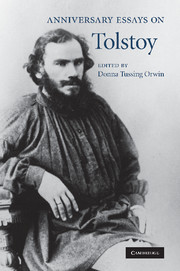Book contents
- Frontmatter
- Contents
- Acknowledgments
- List of contributors
- Introduction
- 1 Tolstoy and music
- 2 Sublime vision and self-derision: the aesthetics of death in Tolstoy
- 3 Tolstoy's peaceable kingdom
- 4 Leo Tolstoy: pacifist, patriot, and molodets
- 5 Leo Tolstoy's correspondence with Nikolai Strakhov: the dialogue on faith
- 6 The worm of doubt: Prince Andrei's death and Russian spiritual awakening of the 1860s
- 7 Tolstoy's spirituality
- 8 Tracking the English novel in Anna Karenina: who wrote the English novel that Anna reads?
- 9 Violence and the role of drama in the late Tolstoy: The Realm of Darkness
- 10 What men quote by: Tolstoy, wise sayings, and moral tales
- 11 The “proletarian lord”: Leo Tolstoy's image during the Russian revolutionary period
- Bibliography
- Index
Introduction
Published online by Cambridge University Press: 03 May 2010
- Frontmatter
- Contents
- Acknowledgments
- List of contributors
- Introduction
- 1 Tolstoy and music
- 2 Sublime vision and self-derision: the aesthetics of death in Tolstoy
- 3 Tolstoy's peaceable kingdom
- 4 Leo Tolstoy: pacifist, patriot, and molodets
- 5 Leo Tolstoy's correspondence with Nikolai Strakhov: the dialogue on faith
- 6 The worm of doubt: Prince Andrei's death and Russian spiritual awakening of the 1860s
- 7 Tolstoy's spirituality
- 8 Tracking the English novel in Anna Karenina: who wrote the English novel that Anna reads?
- 9 Violence and the role of drama in the late Tolstoy: The Realm of Darkness
- 10 What men quote by: Tolstoy, wise sayings, and moral tales
- 11 The “proletarian lord”: Leo Tolstoy's image during the Russian revolutionary period
- Bibliography
- Index
Summary
One hundred years ago, on November 20, 1910 (or November 7, according to the Russian calendar at that time), Count Leo Tolstoy died of pneumonia in the home of the stationmaster at a railway stop called Astapovo. In the seven days during which he lingered, reporters gathered at the obscure station to wire capitals all over the world about his illness and death. It was the first great media circus, made possible by the existence of the telegraph, as well as by Tolstoy's own global reach. He was celebrated not only as a writer of fiction, but also as a moral thinker and reformer whose jeremiads and solutions influenced people everywhere, from Mahatma Gandhi in India, to the founders of the kibbutz movement in Palestine, to Jane Addams, the founder of the settlement movement in Chicago. When I lecture in the older buildings at the University of Toronto or at other universities in North America, I imagine Tolstoy's ideas echoing in these places from the days when my predecessors debated them in the later nineteenth and early twentieth centuries. After Tolstoy's death, there was a battle to assimilate his considerable authority to various causes often at odds with positions he had taken while he was alive and able to defend himself. The concluding chapter in this volume, by Michael A. Denner, documents the different and contradictory ways that Tolstoy was used during the Russian Revolution and its aftermath (1917–24) by all sides of the conflict, from dark red to lily white, about Russia and its future.
- Type
- Chapter
- Information
- Anniversary Essays on Tolstoy , pp. 1 - 7Publisher: Cambridge University PressPrint publication year: 2010



